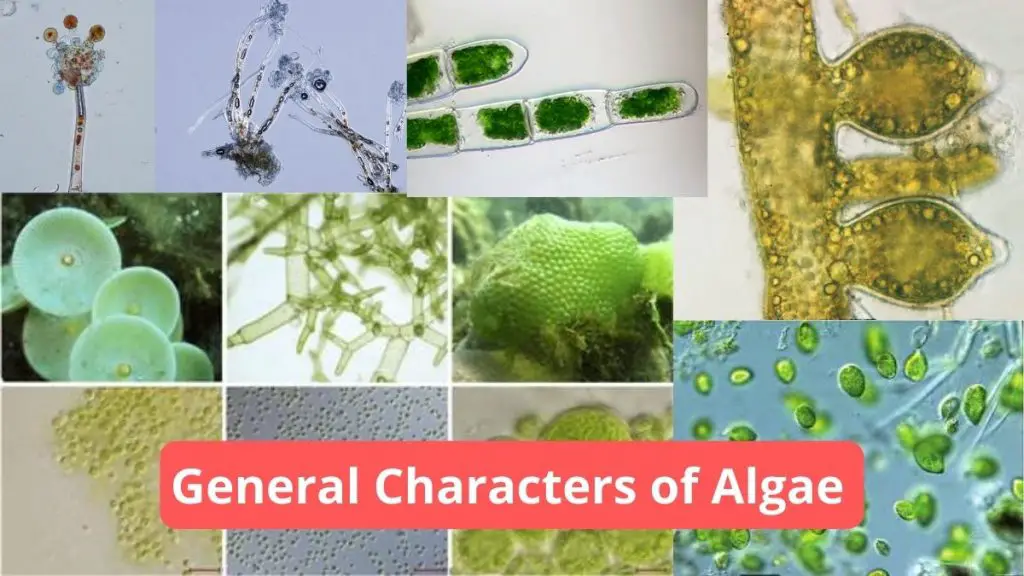Table of Contents
In this article, we will discuss some important characters of algae. Algae is a photosynthetic eukaryotic organisms. They can be found everywhere such as soil, water, rocks, sands, etc. But most of them grow in the aquatic environment. Here is the some General Characters of Algae –

Characters of Algae
1. Occurrence
- Algae are free-floating organisms or aquatic or remain attached to others.
- They can be grown in moist stones, soil, wood, etc.
- Some algae grow in association with fungi (e.g. lichen) & animals (e.g. on the fur of sloth bear).
- On the basis of their habitat or occurrence algae are classified into different groups such as; Aquatic Algae, Terrestrial algae, and Algae of remarkable habitats.
2. Thallus organization
- The algal plant body does not differentiate into root, stem & leaves that is why the algal plant body is a thallus.
- They are variables in sizes and forms.
- They can be unicellular such as Chlamydomonas, or multi-cellular such as Volvox colony, Spirogyra filament.
- Some algae such as brown algae forms a massive plant body (40-60 mt) known as kelps or seaweeds.
- The algal thallus has three important parts such as holdfast (root-like), stipe (stem-like) and lamina or blade (leaf-like).
3. Mucilage
- A thick and gluey substance is covering the whole algae body is known as Mucilage.
- Mucilage protecting the algal body from desiccation & epiphytic growth.
4. Mechanical Tissue
- Algae don’t have any mechanical tissue as buoyancy holds them erect & their flexibility resist the tides without being torn.
5. Vascular Tissue
- They don;t required any vascular tissues for water conduction.
6. Algal plastids
- When algal plastid lacks grana are known as rhodoplasts in red algae, phaeoplasts in brown algae & chloroplasts in green algae.
7. Algal pigments
- Algae has three types of photosynthetic pigment such as chlorophylls (5 types), carotenoids (6 types of Carotenes & 20 types of Xanthophylls) & phycobilins (3 types).
- Most of the algal groups contain Chlorophyll-a and β-carotene.
8. Food reserves
- The food reserves are variable in algal groups such as starch is reserved by green algae, laminarin reserved by brown algae, Floridian starch reserved by red algae, Cyanophycin reserved by Blue-green algae, paramylon reserved by Euglenoids, etc.
9. Vegetative reproduction
- Algae accomplished their vegetative reproduction by fragmentation, fission (e.g. diatoms, desmids), tubers (e.g. Chara), hormogonia (e.g. Nostoc) etc.
10. Asexual reproduction
- Algae accomplished their asexual reproduction by zoospores, aplanospores, hypnospores autospores, tetraspores, carpospores, exospores, endospores, akinetes etc.
11. Sexual Reproduction
- The sexual reproduction in algae is accomplished by the fusion of two specialized haploid cells known as gametes to form a diploid zygote or zygospore (2n).
- Meiosis occurs during the germination process of zygote and develop a new plant is a haploid gametophyte.
- The newly produced haploid gamet is also known as gametangia because it formed a sac-like structure.
- Most of the algae produce flagellated gametes which is known as planogametes & their fusion is called plasmogamy.
- Some algae also formed non-flagellate gametes which is known as aplanogametes & their fusion process in called aplanogamy or conjugation.
- When two types of fusing gametes are produced by the same algal thallus is known as the monoecious or homothallic.
Algal sexual reproduction can be classified into three distinct groups based on the size and movement of gametes, such as;
(i). Isogamy
- This is accomplished by the fusion of two morphologically similar but physiologically distinct gametes.
- These types of morphologically similar but physiologically distinct gametes are known as isogametes and they are produced in vegetative cells called gametangia.
- Example: Isogametes may be planogametes (e.g. Ulothrix, Chlamydomonas) or aplanogametes (e.g. Spirogyra).
(ii) Anisogamy
- This is accomplished by the fusion of two morphologically & physiologically distinct gametes.
- These types of morphologically & physiologically distinct gametes are known as anisogametes.
- In anisogamy, the male gamete is small and more active than the larger female gamete
- Example: Chlamydomonas braunii, Aphanochaete, Phyllobium dimorphum, Enteromorpha intestinalis etc.
(iii). Oogamy
- This is accomplished by the fusion between a smaller motile male gamete and a larger non-motile female gamete.
- Example: antheridum (male sex organ) produces motile male gametes known as antherozoid or spermatozoid whereas oogonium (female sex organ) produces non motile female gamete known as egg or oosphere e.g. Oedogonium,Vaucheria, Chlamydomonas coccifera etc.
12. Life cycle
- There are present five types of life cycle in sexually reproducing algae such as haplontic, diplontic, diplodiplontic (triphasic diplontic), haplo-haplo-haplontic (triphasic haplontic) and haplo-haplontic (diphasic haplontic).


